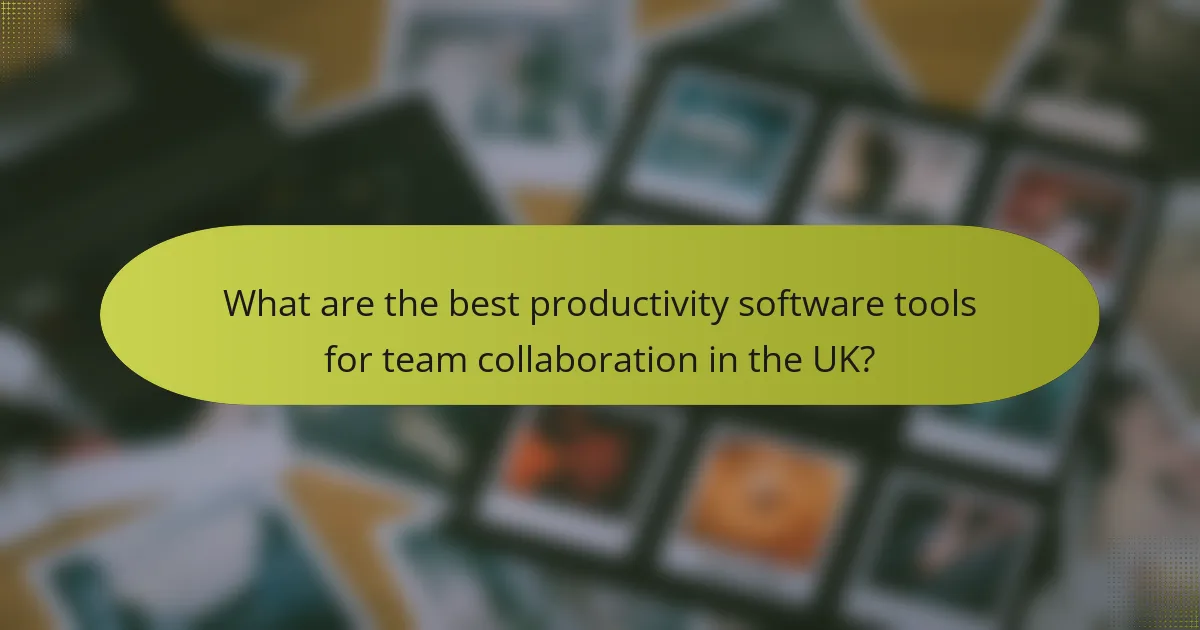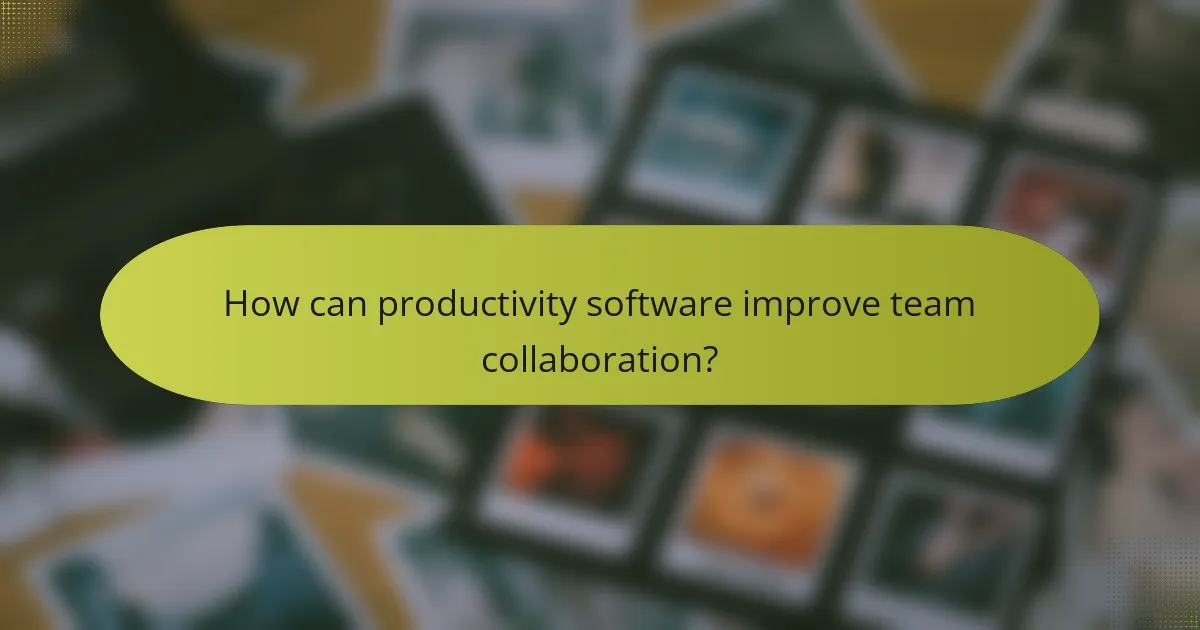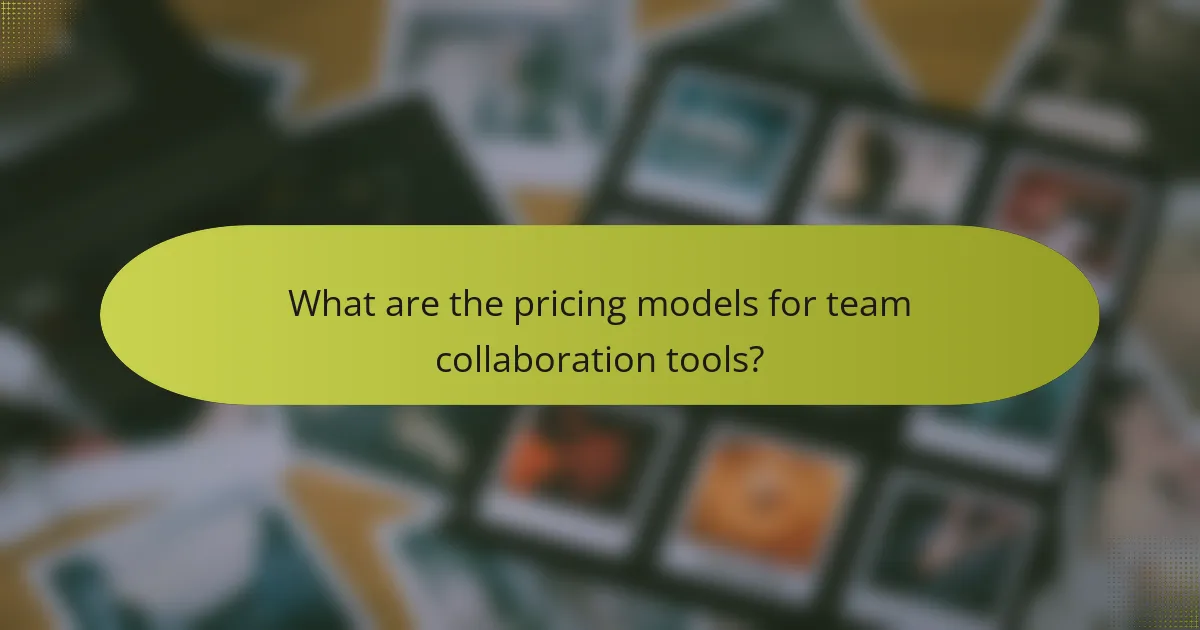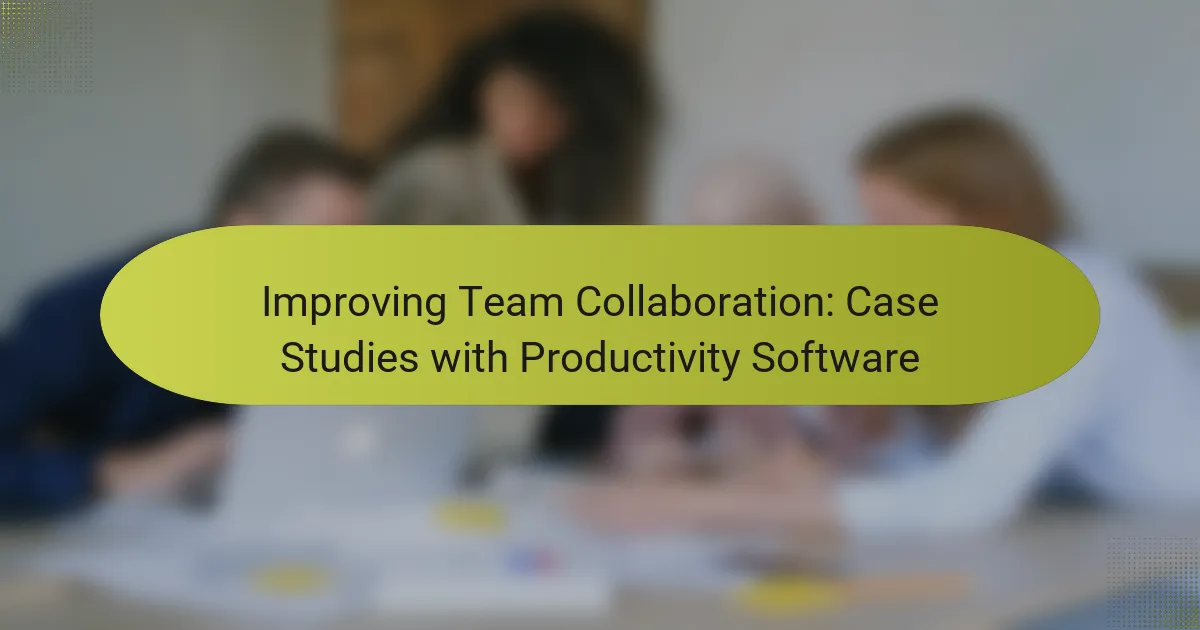Effective team collaboration is essential for maximizing productivity, and leveraging the right software tools can make all the difference. Tools like Slack, Trello, and Microsoft Teams facilitate seamless communication and project management, enabling teams to work more efficiently. By prioritizing features that enhance collaboration and streamline workflows, organizations can significantly improve their overall outcomes.

What are the best productivity software tools for team collaboration in the UK?
The best productivity software tools for team collaboration in the UK include Slack, Trello, Asana, Microsoft Teams, and Google Workspace. These tools enhance communication, project management, task tracking, and document collaboration, making teamwork more efficient and organized.
Slack for communication
Slack is a leading communication platform that allows teams to chat in real-time through channels, direct messages, and threads. This structure helps keep conversations organized and accessible, making it easy to find information later.
Consider using Slack integrations with other tools your team already uses, such as Google Drive or Trello, to streamline workflows. Be cautious of notification overload; setting specific times to check messages can help maintain focus.
Trello for project management
Trello is a visual project management tool that uses boards, lists, and cards to organize tasks and projects. Teams can easily track progress and assign responsibilities, making it ideal for collaborative projects.
To maximize Trello’s effectiveness, establish clear guidelines for how tasks are categorized and updated. Regularly review boards to ensure everyone is aligned and aware of deadlines, which can help prevent bottlenecks.
Asana for task tracking
Asana is a robust task tracking software that allows teams to create, assign, and monitor tasks within projects. Its features include due dates, priority levels, and progress tracking, which help keep teams accountable and on schedule.
Utilize Asana’s reporting tools to gain insights into team performance and project timelines. Encourage team members to update their task statuses regularly to maintain transparency and facilitate better planning.
Microsoft Teams for integrated workflows
Microsoft Teams combines chat, video conferencing, and file sharing in one platform, making it a comprehensive solution for team collaboration. Its integration with Microsoft 365 allows seamless access to tools like Word and Excel directly within the app.
To make the most of Microsoft Teams, create dedicated channels for different projects or topics. This organization helps keep discussions focused and relevant, reducing clutter in communication.
Google Workspace for document collaboration
Google Workspace offers a suite of tools, including Google Docs, Sheets, and Slides, that enable real-time collaboration on documents. Multiple users can edit simultaneously, which enhances teamwork and speeds up project completion.
Leverage Google Workspace’s commenting and suggestion features to facilitate feedback and revisions. Set clear permissions for document access to ensure sensitive information is protected while still allowing collaboration.

How can productivity software improve team collaboration?
Productivity software enhances team collaboration by providing tools that streamline communication, manage projects centrally, enhance accountability, and facilitate real-time collaboration. These features help teams work more efficiently and effectively, leading to improved outcomes.
Streamlined communication
Effective communication is crucial for team collaboration, and productivity software simplifies this process. Tools like instant messaging, video conferencing, and shared channels allow team members to communicate quickly and clearly, reducing misunderstandings.
Consider using platforms that integrate various communication methods, such as Slack or Microsoft Teams, which can help keep conversations organized. Avoid relying solely on email, as it can lead to delays and information silos.
Centralized project management
Centralized project management tools enable teams to track progress, assign tasks, and manage deadlines in one place. Software like Trello or Asana provides a visual overview of project timelines and responsibilities, ensuring everyone is on the same page.
When selecting a project management tool, look for features that allow for easy updates and notifications. This helps prevent tasks from falling through the cracks and keeps team members informed about changes.
Enhanced accountability
Productivity software fosters accountability by clearly defining roles and responsibilities within a team. Tools that allow for task assignments and progress tracking help ensure that everyone knows what is expected of them.
To enhance accountability, consider using software that includes performance metrics or reporting features. This can motivate team members to meet their goals and provide visibility into overall team performance.
Real-time collaboration
Real-time collaboration tools enable team members to work together simultaneously, regardless of their physical location. Software like Google Workspace or Microsoft 365 allows multiple users to edit documents, spreadsheets, and presentations in real-time, promoting a collaborative environment.
When implementing real-time collaboration tools, ensure that all team members are trained on how to use them effectively. This helps maximize the benefits and minimizes confusion during collaborative efforts.

What features should you look for in collaboration software?
When selecting collaboration software, prioritize features that enhance communication, streamline workflows, and integrate with existing tools. Key functionalities include integration capabilities, user-friendly interfaces, mobile accessibility, and customizable workflows, which collectively improve team productivity.
Integration capabilities
Integration capabilities allow collaboration software to connect seamlessly with other tools your team already uses, such as project management systems, email platforms, and file storage services. Look for software that supports popular integrations like Google Workspace, Microsoft 365, or Slack to ensure a smooth workflow.
Consider the ease of integration as well; some platforms offer simple plug-and-play options, while others may require more complex setups. Prioritize tools that provide robust APIs or pre-built connectors to minimize disruption during implementation.
User-friendly interface
A user-friendly interface is crucial for ensuring that all team members can navigate the software efficiently. Intuitive design reduces the learning curve and encourages adoption across diverse skill levels. Look for features like drag-and-drop functionality, clear navigation menus, and customizable dashboards.
Conduct trials or gather feedback from team members to assess usability before making a decision. A software solution that feels familiar and easy to use can significantly boost overall productivity and collaboration.
Mobile accessibility
Mobile accessibility enables team members to collaborate on-the-go, which is essential in today’s flexible work environments. Ensure that the software has a responsive design or dedicated mobile apps that provide full functionality, allowing users to communicate and manage tasks from their smartphones or tablets.
Evaluate the performance of mobile features, such as notifications, document sharing, and task updates, to ensure they meet your team’s needs. This flexibility can enhance productivity, especially for remote or field-based employees.
Customizable workflows
Customizable workflows allow teams to tailor the software to fit their specific processes and preferences. Look for platforms that enable users to create unique task assignments, approval processes, and communication channels that align with their project requirements.
Consider tools that offer templates or automation features to streamline repetitive tasks. This adaptability can lead to more efficient collaboration and help teams focus on their core objectives without unnecessary distractions.

What are the pricing models for team collaboration tools?
Team collaboration tools typically utilize various pricing models, including subscription-based, freemium, and one-time purchase options. Understanding these models helps organizations choose the right tool based on their budget and collaboration needs.
Subscription-based pricing
Subscription-based pricing is a common model where users pay a recurring fee, often monthly or annually, to access the software. This model usually includes updates, support, and additional features as they are released, ensuring users always have the latest tools.
Costs can vary widely, typically ranging from around $5 to $30 per user per month, depending on the features offered. Companies should assess their team size and required functionalities to determine the most cost-effective plan.
Freemium models
Freemium models allow users to access basic features of a collaboration tool for free, with the option to upgrade to a paid plan for advanced features. This approach is beneficial for teams that want to test a tool before committing financially.
While the free version may suffice for small teams or simple projects, larger teams or those needing more robust functionalities may find themselves needing to upgrade. Be cautious of limitations in storage or user capacity in the free version.
One-time purchase options
One-time purchase options require users to pay a single fee to obtain the software, often resulting in lower long-term costs. However, this model may not include ongoing updates or support, which can lead to additional expenses over time.
This model is less common for cloud-based collaboration tools but can be found in desktop applications. Consider the total cost of ownership, including potential upgrade fees, before opting for a one-time purchase.

How do you measure the effectiveness of collaboration software?
Measuring the effectiveness of collaboration software involves assessing various metrics that indicate how well teams are working together. Key areas to focus on include user engagement, project completion rates, and team feedback.
User engagement metrics
User engagement metrics provide insights into how actively team members are utilizing collaboration software. Metrics such as login frequency, time spent on the platform, and the number of messages or comments exchanged can reveal the level of interaction.
For example, a high login frequency combined with substantial time spent on the platform typically indicates strong engagement. Aim for at least 75% of team members to log in daily for optimal collaboration.
Project completion rates
Project completion rates measure the percentage of tasks or projects finished on time using the collaboration software. Tracking these rates helps identify bottlenecks and areas for improvement.
For effective evaluation, compare completion rates before and after implementing the software. A target completion rate of 80% or higher is generally considered successful, but this can vary by industry and project complexity.
Team feedback surveys
Team feedback surveys are essential for gathering qualitative insights about the collaboration software’s effectiveness. Regularly soliciting feedback can help identify user satisfaction and areas needing enhancement.
Consider conducting surveys quarterly, asking team members to rate their experience on a scale of 1 to 10. Aim for an average score of 7 or above to indicate a positive perception of the software’s impact on collaboration.



